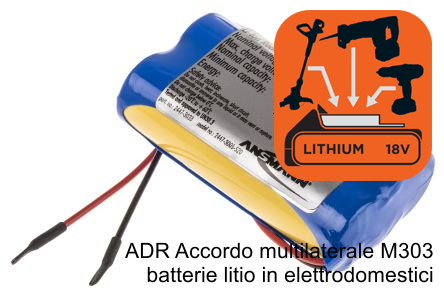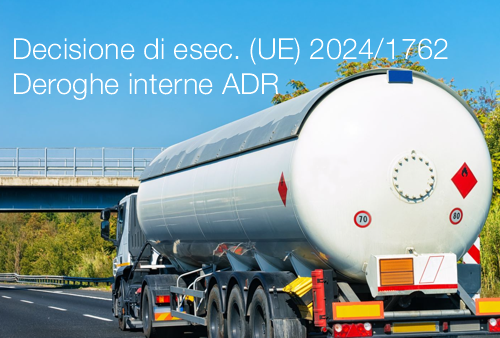Informazione tecnica HSE / 25 ° anno
/ Documenti disponibili:
43.929
/ Documenti scaricati: 31.189.427
/ Documenti scaricati: 31.189.427
Circolare Prot. n. 10898 DIV 3/E del 5 aprile 2011
Oggetto: Consulente al trasporto di merci pericolose - Relazione annuale - Modifica della circolare A/9 del 6 marzo 2000.
La Circolare A/9 del 6 marzo 2000 (prot. 513/4915/10), emanata in attuazione del D.L.vo 4 febbraio 2000, n. 40, prescrive che entro il 31 dicembre di ogni anno il Consulente alla sicurezza per il trasporto di merci pericolose debba consegnare la relazione annuale riferita all’attività di trasporto [...]
Following the events of September 11 2001, international legislators considered it necessary to develop and implement measures regarding security for the transportation of goods by road, rail and inland waterways against possible terrorist risks.
On the basis of relevant UN recommendations security provisions – as opposed to classic safety provisions – have been listed in a new ADR Chapter 1.10 and address all parties involved in [...]
Guidelines Security ADR Cap. 1.10
Industry Guidelines for the Security of the Transport of Dangerous Goods by Road
Security measures should be an integral part of the safety and quality management system of
every company involved with the transport of dangerous goods.
The general requirements of ADR Chapter 1.10 are mandatory. However, the specific ways they are addressed will depend upon the individual circumstances of the undertakings in a particular transport chain and their assessment of the risks and possible outcomes.
For example,
1 Introduction
1.1 The history of the container
1.2 Container flows
1.3 Maritime transport of containers
1.3.1 Container-carrying vessels
1.3.1.1 Part 1
1.3.1.2 Part 2
1.3.2 Positioning and securing of containers on board
1.3.3 Container stowage plans
1.4 Containers and insurance
1.4.1 General
1.4.2 Containers and cargo insurance
1.4.3 Containers and container & hull insurance
1.4.4 Liability of transport company
1.4.4.1 Container provided by shipper
1.4.4.2 Container provided by carrier
1.5 Responsibility for packing
2 Causes of damage/loss during transport
2.1 Loss prevention through training
2.2 Damage - risks - countermeasures
2.3 Shipping stresses - general information
2.3.1 [...]
La Direzione Generale per la Motorizzazione ha predisposto dei quiz aggiornati con l'ARD/RID 2013, per i candidati che si accingono a sostenere l'esame per il conseguimento o il rinnovo del certificato di formazione professionale di consulente per la sicurezza del trasporto di merci pericolose.
Tali quiz rappresentano materiale in sede di esame per il conseguimento/rinnovo del suddetto certificato, fermo restando che le Commissioni di esame nella loro autonomia possono predisporre [...]
Ed. 5a Amendment 2
The Manual of Tests and Criteria contains criteria, test methods and procedures to be used for classification of dangerous goods according to the provisions of Parts 2 and 3 of the United Nations Recommendations on the Transport of Dangerous Goods, Model Regulations, as well as of chemicals presenting physical hazards according to the Globally Harmonized System of Classification and Labelling of Chemicals (GHS).
As [...]
Sottoscritto l'Accordo multilaterale M281 tra Germania e Belgio
ai sensi del paragrafo 1.5.1 dell'allegato A di ADR, per quanto riguarda il trasporto di rifiuti contaminati con i virus che causano febbre emorragica.
In deroga alle disposizioni del capitolo 6.3 e istruzione d'imballaggio P620 del 4.1.4.1, i rifiuti che sono stati contaminati con o che si presume essere stati contaminati con una virus della febbre emorragica, come Ebola, per il trasporto allo smaltimento finale, possono [...]
DIRETTIVA 2014/103/UE DELLA COMMISSIONE del 21 novembre 2014 che adegua per la terza volta al progresso scientifico e tecnico gli allegati della direttiva 2008/68/CE del Parlamento europeo e del Consiglio relativa al trasporto interno di merci pericolose
La nuova rubrica UN 3509 (Classe 9 - D.S. 663) è stata introdotta con l’ADR 2015.
Tale rubrica, modificherà in modo rilevante l'aspetto degli "imballaggi di scarto" che abbiano contenuto merci pericolose, tale sì, eventualmente, da individuarsi anche negli imballaggi-rifiuto.
La nuova identificazione è la seguente:
UN 3509, IMBALLAGGI DI SCARTO, VUOTI, NON RIPULITI, 9.
Nel Documento di Trasporto la dicitura corretta dovrà essere completata dalla classe(i) e rischio sussidiario(i) corrispondente ai [...]
Modello Istruzioni scritte Cap. 5.4.3 + Pagina 0 di Informazioni Preliminari (P.0)
Adotta il nostro modello di "Istruzione di Sicurezza in 4 pagine" previste dall'ADR 2013 + Pagina 0 "P.0" di INFORMAZIONI PRELIMINARI, dove possono essere sono riportate:
- le eventuali Indicazioni Supplementari (Pagina 3 Nota 2 Istruzioni Scritte ADR)
- Altre informazioni da fornire sull'incidente e sulle materie coinvolte (Pagina 1 Istruzioni Scritte ADR)
UN Recommendations on the Transport of Dangerous Goods
Model Regulations 18a revised edition
Table of contents
Volume I (Recommendations, Parts 1 to 3, Dangerous Goods List, Appendices and Alphabetical Index)
Volume II (Parts 4 to 7 and Table of Correspondence)
Part 1: General provisions, definitions, training and security
Part 2: Classification
Part 3: Dangerous goods list, special provisions and exceptions
Corrigendum 1
Corrigendum 2
Appendices
Alphabetical index of substances and articles
Part 4: Packing and tank provisions
Part 5: Consignment procedures
Part 6: Requirements for the construction and testing of packagings,
Esenzione trasporto lampade in generale (“lamps” da “light bulb”) anche usate.
Aggiunta l’esenzione relativa al trasporto per le lampade non solo elettriche ma in generale contenenti merci pericolose nuove ed usate (es taluni gas ionizzanti) in determinate condizioni e modalità di imballaggio e trasporto.
Esteso il concetto di lampade (lamps) da quello di lampade elettriche (light bulb)
***non official translate***
1.1.3.10
Esenzioni relative al trasporto di lampade contenenti merci pericolose
I seguenti [...]
Entro il 1° ottobre 2014, nessuna delle parti contraenti dell'accordo ADR ha comunicato un'obiezione al Segretario generale.
Di conseguenza, secondo le disposizioni dell'articolo 14 (3), dell'accordo, le modifiche proposte agli allegati A e B, come modificato entra in vigore per tutte le parti contraenti il 1° gennaio 2015.
These guidelines provide a list of practical options on how a company can meet the requirements of the Chapter 1.10 on Security Provisions in ADR 2013.
They are the result of a cooperation between 11 industry associations, which represent a large part of manufacturing, transport, distribution and forwarding industries, involved in the transport of dangerous goods.
These Guidelines have been designed to provide as comprehensive a range of [...]
European Agreement concerning the International Carriage of Dangerous Goods by Road (ADR 2015)
Published:September 2014
Adopted on 30 September 1957 in Geneva under the auspices of the United Nations Economic Commission for Europe (UNECE), the ADR entered into force on 29 January 1968.
This authoritative Agreement is intended to increase the safety of international transport of dangerous goods by road. Its Annexes A and B contain the technical requirements for road [...]
A Guide For Business
This guide for business is geared towards businesses that are involved in the consignment, loading/unloading and carriage of dangerous goods by road.
Dangerous goods are substances and articles which have been identified as hazardous for transport and present a risk to people, property and the environment.
The guide has been arranged to provide a comprehensive summary of the legal provisions of the ADR (European Agreement Concerning the International Carriage of Dangerous [...]
ID 953 | 22.08.2014 / In allegato
Quando si trasporta un carico, fissarlo in modo adeguato permette di evitare danni al veicolo e lesioni ai passeggeri o ad altri utenti della strada, e di evitare ingorghi dovuti alla perdita del carico.
Il carico non assicurato adeguatamente può cadere, sbilanciare il veicolo e a volte può perfino farlo rovesciare e urtare altri veicoli.
Il 25% degli incidenti che coinvolgono autocarri è dovuto ad un inadeguato fissaggio [...]
L'accordo multilaterale M268 e l'ADR 2015
Su iniziativa francese è stato sottoscritto nel Dicembre 2013, in deroga dall'ADR - 1.5.1, l’Accordo Multilaterale M268 inerente gli imballaggi di scarto a cui hanno aderito, ad oggi, i paesi:
France 3/12/2013
Belgium 11/12/2013
Spain 20/12/2013
Netherlands 19/12/2013
Germany 7/03/2014
Switzerland 24/03/2014
Portugal 12/06/2014
L’accordo non è ad oggi stato sottoscritto dall'Italia.
L’accordo M268 anticipa l’applicabilità della nuova rubrica UN 3509 (Classe 9 - Disposizione speciale [...]
The European Agreement Concerning the International Carriage of Dangerous Goods by Road (ADR), done in Geneva on 30 September 1957, entered into force on 29 January 1968 in accordance with its article 7.
On 1 August 2013, there were 48 Contracting Parties to ADR:
Albania,
Andorra,
Austria,
Azerbaijan,
Belarus,
Belgium,
Bosnia and Herzegovina,
Bulgaria,
Croatia,
Cyprus,
Czech Republic,
Denmark,
Estonia,
Finland,
France,
Germany,
Greece,
Hungary,
Iceland,
Ireland,
Italy,
Kazakhstan,
Latvia,
Liechtenstein,
Lithuania,
Luxembourg,
Malta,
Montenegro,
Morocco,
A Guidebook for First Responders During the Initial Phase of a Dangerous Goods/Hazardous Materials Transportation Incident
The Emergency Response Guidebook: A Guidebook for First Responders During the Initial Phase of a Dangerous Goods/Hazardous Materials Transportation Incident (ERG) is used by emergency response personnel (such as firefighters, and police officers) in Canada, Mexico, and the United States when responding to a transportation emergency involving hazardous materials.
First responders in Argentina, Brazil, and Colombia have recently began using the [...]
In vigore definitivamente dal 1° Luglio 2013
Un documento escursus sulle principali novità dell’ADR 2013 che entra definitivamente in vigore il 1° Luglio 2013.
In sequenza:
Parte 1 – Disposizioni generali
Parte 2 – Classificazione
Parte 3 – Lista delle merci pericolose
Parte 4 – Utilizzazione di imballaggi e cisterne
Parte 5 – Procedure di spedizione
Parte 6 – Costruzione e di prove imballaggi, IBC, Cisterne, …
Parte 7 – Trasporto, carico, scarico, movimentazione
Parte 8 – Equipaggiamento, equipaggio ed esercizio dei veicoli [...]
ADR 2013
European Agreement concerning the International Carriage of Dangerous Goods by Road
ADR applicable as from 1 January 2013
The European Agreement concerning the International Carriage of Dangerous Goods by Road (ADR) was done at Geneva on 30 September 1957 under the auspices of the United Nations Economic Commission for Europe, and it entered into force on 29 January 1968. The Agreement itself was amended by the Protocol amending article 14 (3) done at New York [...]
Allegato A - Disposizioni generali e disposizioni relative alle materie e oggetti pericolosi
Parte 1 - Disposizioni generali
Parte 2 - Classificazione
Parte 3 - Lista delle merci pericolose, disposizioni speciali, esenzioni relative alle merci pericolose imballate in quantità limitate e in quantità esenti
Parte 4 - Disposizioni relative alla utilizzazione degli imballaggi e delle cisterne
Parte 5 - Procedure di spedizione
Parte 6 - Prescrizioni relative alla costruzione e alle prove degli imballaggi, dei contenitori intermedi per il trasporto alla rinfusa (IBC), dei grandi imballaggi, delle cisterne [...]
Agg. January 2012 – Corrigendum 2
European Agreement Concerning the International Carriage of Dangerous Goods by Road
UN Recommendations on the Transport of Dangerous Goods, Model Regulations - 17 edition.
Versione ufficiale in lingua Inglese
www.unece.org
Copyright © United Nations, 2011
Elaborazione Certifico - Formato Adobe portofio pdf
Rev. 02.2012
Corrigendum 2
Ref. Sales No.: R.10.VIII.4
(ECE/TRANS/215)
January 2012
New York and Geneva
European Agreement Concerning the International Carriage of Dangerous Goods by Road
Versione ufficiale in lingua Inglese
ID 867 | 28.07.2014
An introduction to the basic principles of risk assessment for chapter 1.9 ADR
Document adopted at the 84th and 85th sessions of the Working Party on the Transport of Dangerous Goods (WP.15) in May and October 2008.
Contents
1. Introduction
1.1 Background
1.2 Guideline Objectives and Application
2. Basic Definitions and Requirements
2.1 Definition of Technical Terms
2.2 Basic parameters3. Risk Analysis
3.1 Introduction
3.2 Scenario Definition
3.3 Statistical [...]
Circolare MIT 25692 del 13/09/2011
Si informano codesti Uffici che l’Italia ha sottoscritto gli Accordi Multilaterali M235 e M240.
Gli Accordi summenzionati, di cui si allega copia, prevedono deroghe per il trasporto su strada di merci pericolose.
Gli Accordi multilaterali di cui sopra sono finalizzati a risolvere le difficoltà iniziali correlate alla nuova classificazione degli oli combustibili.
Infatti a seguito della recente riclassificazione effettuata dal CONCAWE secondo i criteri della Direttiva 67/548/CEE e del Regolamento n.

22 Maggio 2017: siglato Italia
Accordo Multilaterale M303 nell'ambito della sezione 1.5.1 ADR riguardante il trasporto di accumulatori ...

ID 2197 | 08.02.2020
In allegato all'articolo una Scheda di Gestione Trasporto Rifiuto amianto CER 170601 / ADR
L’amianto o asbesto è un minera...

ID 22140 | 28.06.2024
Decisione di esecuzione (UE) 2024/1762 della Commissione, del 5 giugno 2024, che modifica la direttiva 2008/68/CE del...
Testata editoriale iscritta al n. 22/2024 del registro periodici della cancelleria del Tribunale di Perugia in data 19.11.2024